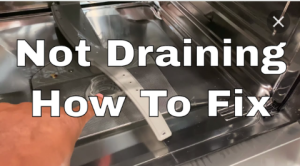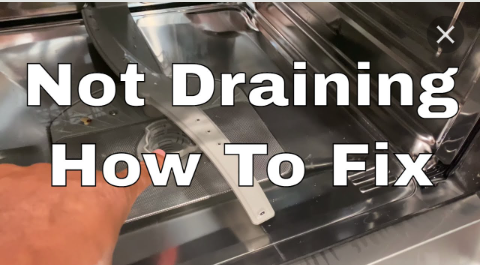Let’s know how to unclog a dishwasher with standing water. When a dishwasher won’t drain, it’s one of the issues that homeowners most frequently call plumbers about. Opening the dishwasher door to find standing water at the bottom might be a stressful experience, but it isn’t necessarily a sign of a plumbing catastrophe. In reality, you might be able to solve the issue on your own without consulting a specialist.
How to unclog a dishwasher with standing water

After supper, you finish off your cleaning and fill the dishwasher. But later that evening, when you open your appliance to store your clean dishes, you discover a pool of water and a ton of filthy plates and cutlery. Most likely, the drain in your dishwasher is not working properly.
So, it is important to know how to unclog a dishwasher with standing water. But what signs do you look for in a clogged dishwasher? You probably have a clogged dishwasher if it’s not draining very well or if an inch or more of standing water constantly gathers in the bottom of the tub. The last thing you need is a broken, stinky dishwasher given all of your daily concerns. Who has the time or the flexibility to wait for a service specialist to come out to fix a dishwasher that won’t clean your dishes?
Fortunately, there are a few fixes you may try before hiring a technician to unclog the dishwasher.
The most common causes of your dishwasher’s drainage problems
Before we know How to unclog a dishwasher with standing water we should look at the most common causes of your dishwasher’s drainage problems.
Determine the underlying problem if there is water in the bottom of your dishwasher.
Clogs, insufficient upkeep, operation mistakes, and broken pieces or malfunctioning parts are the most frequent causes of water in the bottom of your dishwasher.
Clogs: The most frequent causes of improper water drainage are blockages. Dishes should always be rinsed before going into the dishwasher to avoid clogging.
I go into great detail on how to unclog each of the several elements and systems of your dishwasher that may become clogged in a minute.
Insufficient upkeep: The majority of consumers are unaware that routine maintenance is necessary to maintain their dishwasher functioning properly.
Regular upkeep might involve routinely cleaning filters, examining hoses, and emptying the drain basket.
The spray arm should also be cleaned and inspected every six months or as recommended in your owner’s handbook.
Operation Mistakes: To guarantee appropriate operation procedures, review your owner’s handbook at all times. It’s crucial to understand how to operate the device and which goods are suggested.
For instance, using ordinary dish soap in a pinch might result in a blockage and water in the dishwasher’s bottom.
Broken Pieces: To avoid voiding your guarantee, components that wear out should be replaced by contact a qualified specialist.
How to Stop Soap Suds in Dishwasher?
How to unclog a dishwasher with standing water using troubleshooting techniques
Important Steps to unclog a dishwasher with standing water:
Conduct a full cycle
After turning on the system’s electricity, conduct a full cycle of dishwashing to make sure your dishwasher is draining properly. Open the dishwasher door once the cycle is finished to see whether any water is still in the bottom.
You might need to hire a pro if the dishwasher has an unusually large volume of standing water. Set up a time for a repair specialist to visit your dishwasher and submit a claim if you have a home warranty coverage with your provider.
Cut the power to the apparatus
To avoid electric shock, disconnect the dishwasher or flip the switch in your electrical panel before performing any maintenance.
Drainage system inspection
Your dishwasher doesn’t drain properly? Food scraps or other material clogging the drainage system is one of the most frequent causes of water at the bottom of your dishwasher.
Check the dishwasher’s drain, clean the area surrounding the bottom sprayer arm, and use a wire hanger to clear any obstructions with debris. Make sure no huge things are blocking or covering the tub’s back sump region.
Drain line cleaning
The drain line is under the filter screen near the rear of the dishwasher. To make a paste, combine 1/2 cup baking soda with 1/2 cup water. The paste should be poured into the drain line through the filter screen.
Pour half a cup of vinegar down the drain, then wait 15 minutes before using the solution.
To remove the baking soda solution, flush the drain line with hot water after 15 minutes.
Straighten the drain hose. The dishwasher drain pipe should be located under the sink and is often held in place by clips or screws. Older drain hoses can develop kinks that might result in obstructions. Straighten up any kinks in the drain tube with gentle pressure.
How to unclog a dishwasher with standing water by Evaluate the supply chain
If there is remaining water in your dishwasher after cleaning the screen and the drainage regions, your supply line is probably clogged. Find your sink’s supply line there.
Disconnect the plumbing line that feeds into the main drain and place a bucket below it to catch any water that may fall. Allow the water to drain into the bucket, check for obstructions, and then use a snake to free the pipe. Simply reconnect the plumbing line after clearing any obstructions, then start the dishwasher’s empty cycle.
Best Bootle Dishwasher: impressive guid
Switch on the waste disposal: Important Step of learning how to unclog a dishwasher with standing water
Remove the drain hose where it attaches to the trash disposal and clear obstructions with a flat-head screwdriver since an air gap in a connected hose might prevent water from emptying. Check to see that the kitchen sink drain is clear after clearing any obstructions, then run the garbage disposal. Never put your hands in the garbage disposal since doing so might seriously hurt you.
Refresh the sprayer arms by cleaning it with Clog Removal
The sprayer arms on your dishwasher’s bottom may be removed with care. With a wire hanger, clear the apertures of any food particles.
Make sure all food debris is gone before giving the arms a warm water rinse, then put them aside.
How to unclog a dishwasher with standing water by washing the pump
The pump has two impellers: one at the top that empties water into the dishwasher and one at the bottom that empties it into the drain. Water can accumulate when debris, such as shattered glass, blocks the impellers from rotating. If you come across any debris that could be causing these obstructions, remove it.
Wash the dishwasher’s filter
Use a screwdriver to remove the dishwasher filter, which is often found on the bottom of the dishwasher floor close to the rear of the appliance. To find its location, see your owner’s handbook. Clean the surrounding area with a moist sponge after rinsing the screen with water. Replace the sprayer arms and screen.
Your dishwasher’s water should be drained
Use towels to cover the area underneath the dishwasher, and then scoop the water into a big bowl or the sink using a large cup or plastic container. Use a towel to absorb the remaining moisture until the water is too shallow to scoop.
Dishwasher clog avoidance techniques
Even though there are some simple ways to avoid them, dishwasher blockages may be a genuine pain. From our experts, take note of the following advice:
Only rinse your dishes to get rid of any substantial food particles that can block the dishwasher’s drain. The optimal performance of your dishwasher and dishwashing detergent depends on the presence of food particles on your plates.
Check that the dishwasher and all of its parts are in good operating condition before you start washing dishes. Before starting a cycle, you should address any visible accumulation in the filter or improper positioning of the sprayer jet.
A hot water cycle will frequently assist in removing any remaining buildup and preventing blockages in the future.
To stop any accumulation that might lead to a blockage before it occurs, clean the dishwasher’s inside, exterior, and filter at least once a month.
Last but not least, a dishwasher benefits from regular usage; thus, run cycles often rather than leaving it inactive for extended periods.
When to Contact a Specialist
Opening your dishwasher after a cycle and seeing a puddle of water at the bottom might be unsettling.
The good news is that most of the time, it’s a problem that can be solved without a specialist’s assistance.
As I mentioned about how to unclog a dishwasher with standing water, the root cause of the issue is typically a systemic obstruction that prevents water from draining properly. Finding and removing the obstruction is the first step in fixing it.
What if you’ve tried every remedy in this post and your issue persists?
Unfortunately, there may still be a problem with your dishwasher that only a specialist can fix.
Do you have other advice for removing water from the dishwasher’s bottom? Tell us in the comments section below!
FAQs:
What could be causing standing water in my dishwasher?
A filthy filter is the most common reason for dishwasher drainage issues.
How can I safely unclog my dishwasher’s drainage system?
Scrubbing it with a mixture of vinegar and baking soda in a 1:1 ratio.
Are there common household items I can use to unclog a dishwasher?
You might use a cup of vinegar and a cup of baking soda.

